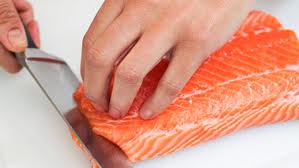 1. Use a boning knife to fillet fish. The firmer blade will make the procedure easier and produce a neater fillet
1. Use a boning knife to fillet fish. The firmer blade will make the procedure easier and produce a neater fillet
2. When removing both fillets from a whole fish, remove the head and run the knife between the flesh and spine towards the tail. Only do this halfway on one side, completely remove the fillet underneath then flip the fish back over to finish removing the remaining fillet.
3. Never use oily fish remains to make stock as it is too fatty and rich. Meaty, white fish is best with flat fish being a particularly good option
4. Fresh fish can be identified by the clarity of the eyes, the redness of the gills and the overall aroma, which should be of the sea and not ‘fishy’. A good test is to prod the fish with a finger – a fresh fish’s skin will be firm and keep its shape. If your finger leaves an imprint, it’s likely the creature has been separated from its source for quite some time.
5. To successfully separate the skin from a fish fillet, place the fillet skin side down and, using a sharp knife, cut through some flesh at the tail end until you get to the skin underneath. Place the knife between the flesh and skin then, holding the skin taught and the knife firmly at a downward angle, pull the skin towards you allowing the knife to run between the flesh and skin until you have reached the wider end of the fillet and completely separated the two.
Tips from a Fish Masterclass at the recently opened Class Rooms Culinary Academy, London
